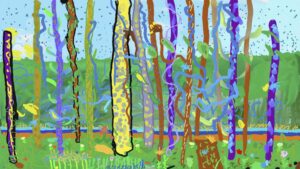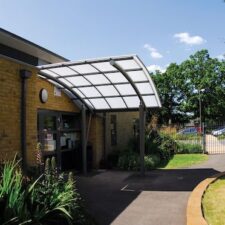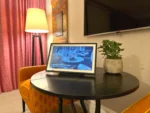Amesbury School Get Creative with Samsung Flip Screen – The Digital Line (TDL) talks to Kerry Tristram, Head of Visual Art at Amesbury School, Hindhead.
Following on from the Flip Art competition last year in conjunction with the Samsung Flip Screen, The Digital Line was thrilled to hear an update from the art department at Amesbury School.
The Flip Screen has enabled the school to embed digital art into their teaching and learning across a whole range of projects and the pupils are loving engaging with it.

What were your initial thoughts regarding the digital board?
“I knew that the children would be excited and keen to get using it. I thought it was great that the flip screen was large scale, and we would stand at it to use it. I liked the fact that this would be different to the children’s usual experience of using technology such as laptops and iPads where they are mostly sat and limited to a small screen. I also liked the fact that it is a touch screen and responsive to real brushes. This makes it accessible and simulates the experience of a real painting.
“I wasn’t sure how we could make the best use of it in lessons initially or how we could get a whole class involved with using it effectively.”
Were the pupils quick to accept the concept of the new technology?
“Yes, the children have responded intuitively to the touch screen technology and are happy to explore to find out how it functions and what is possible”.
What projects at school are the pupils enjoying engaging with?
“Our Year 4 pupils have created collaborative landscape paintings inspired by David Hockney’s digital landscapes.
“Our Year 5 pupils were looking at abstract art and in particular the work of Kandinsky and painting in response to music. They were able to do this on the Flip screen alongside using watercolours on paper, choosing a favourite section they had created on their page and recreating it on the screen, using watercolour mode. The final digital piece was a composition of all their chosen sections, creating a new piece of work.
“During Safer Internet Day, where our youngest children were learning about how technology can be used, they made large scale collaborative paintings on the floor using paint and brushes, whilst working on the Flip screen one at a time to create a collaborative digital painting”.
Do the pupils work individually or as a group on the digital flip screen or both?
“As only one person can use it at a time, we have found that it is best to give each child some time to add to a class piece that is created over a period of a few lessons. This has worked well with each child working to build up layers of detail without taking away or completely covering what another child has done. As a result, we have been able to create a finished piece that everyone in the class has contributed”.
Is there any art style the pupils prefer to use i.e., large/small brush – water/oil paint styles?
“The pupils have enjoyed being able to select different size brushes to use. They clearly have enjoyed the liberation that comes from using a large brush and sweeping it across a large screen. They have probably enjoyed the acrylic paint mode the most.
“It certainly has therapeutic benefits and I have used it for therapeutic art sessions with some of our pupils.
“Some of our older pupils have commented that they would like to be able to switch between pen and paint modes so that they could draw and paint on the same piece”.
What has impressed you most about using the digital screen?
“I have been impressed by how easy it is to use. I think the function of the paint mixing is fantastic as it is much closer to how real paint behaves and the children are captivated by observing this. Also, the fact that you can dry the paint to stop it from mixing gives you a good level of control.
“We were interested to see the two digital landscape painting images attached (influenced by the work of Hockney) completed by 2 classes of Year 4 pupils (aged 8-9 years). Each painting has been created by 16 pupils working in collaboration to build up the layers of colour, pattern, and detail”.
Tags: Amesbury School, Art, Education, Flip Screen

 Share On Facebook
Share On Facebook Tweet It
Tweet It











